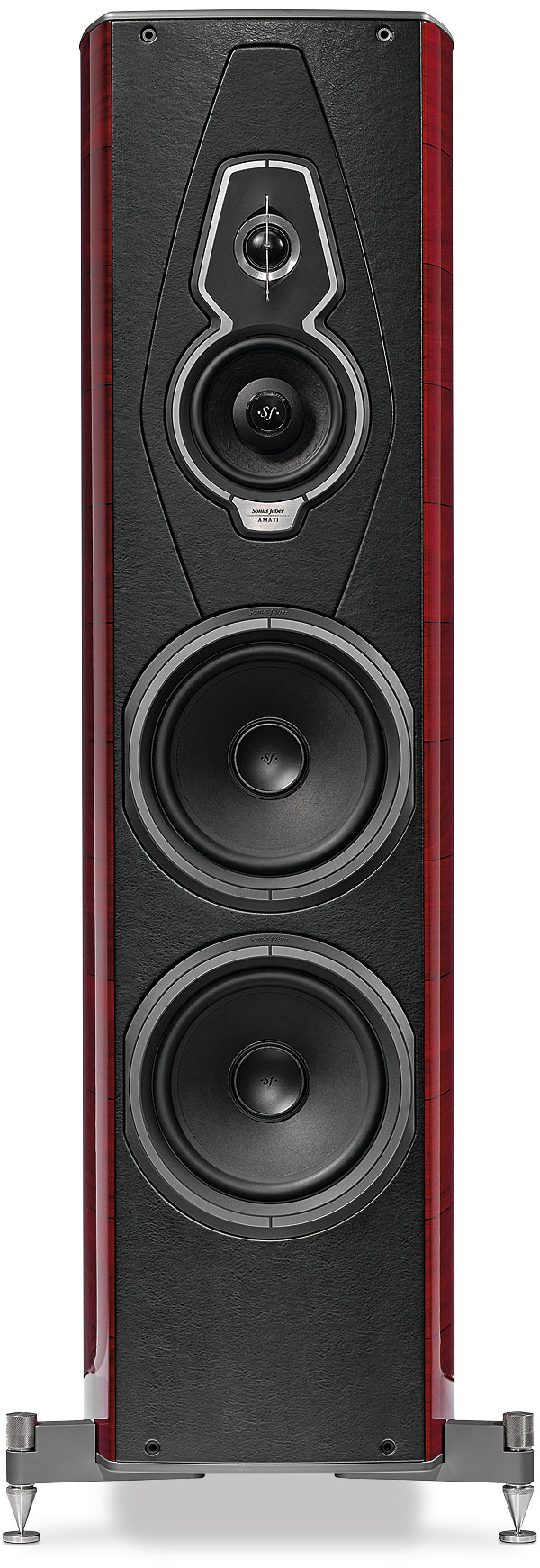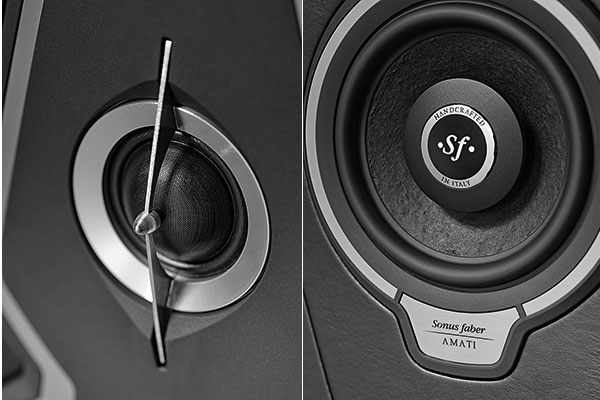Sonus faber Homage Amati G5 Loudspeaker

 With an impressive back-story, impeccable engineering and glorious finishes, these imposing '5th generation' Italian speakers promise much – so do they deliver? Certo!
With an impressive back-story, impeccable engineering and glorious finishes, these imposing '5th generation' Italian speakers promise much – so do they deliver? Certo!
The Amati G5 sits at the top of a four-strong new 'fifth generation' range of the company's Homage speakers, so-called because they pay tribute to the tradition of musical instrument manufacturing in Cremona, Italy. And they do so not just in name, but in the way they're made, with extensive use of selected woods, handcrafting based on the work of traditional luthiers of the past, and even a lute-shaped profile, which first saw the light of day in the previous Homage series [HFN Oct '17].
But there's even more resting on this latest lineup: it is, after all, 30 years since the original Guarnieri standmount speaker was launched. In its latest iteration, the Guarnieri is now £13,000, with a pair of dedicated stands at £3200, while the Serafino G2 is £22,000, and the Amati G5 we have here at £30,000 a pair. A dedicated centre speaker, the Vox G3, completes the range at £14,000, and the speakers are available in red, wenge (a very dark chocolate brown) and graphite finishes.

Crowning Carpentry
It should be acknowledged that 'finishes' has a slightly different meaning here to that in more conventional speaker designs, where the finish is usually a thin layer of veneer over an MDF enclosure. In these Sonus faber speakers, multiple layers of wood are used, with the production process having been refined in recent years following the company's 2021 acquisition of the Di Santi woodworking company, previously a supplier for 35 years.
That was a logical development for the company, known in more recent times for its luxury take on fairly conventional speaker design, handcrafted in solid wood. Using its now in-house expertise, Sonus faber has been able to retain and refine that lute profile (most visible when viewing the speaker from above) and improve the bracing and porting of the cabinet, which is made up from 'slices' of solid wood rather than the more usual one-piece panels. In practice, nine layers of wood are used in the cabinets, before sanding and hand-finishing with multiple layers of lacquer. The lute-shaped braces are constrained in place all the way down the 'tower', contributing significantly to the strength of the speakers.
Completing the stiffening job here is the use of aluminium 'dampshelves' at the top of the cabinet, further increasing its rigidity and reducing resonance without resorting to the long TMD (tuned-mass damper) used in the Amati Tradition. All this explains why these speakers may not be huge, at just over 117.5cm tall, but still weigh a substantial 55.5kg apiece.

New for this generation are smoothed edges trimmed with graphite grey anodised metalwork, while those internal bracing and porting changes aim for greater sensitivity and bass output. But it's in the treble and midband sections of this 3.5-way design that the changes are greatest, not least in the adoption of the company's latest 'semi-balanced Paracross' crossover. That design has been developed through a combination of simulation and listening, as have the efforts to ensure all the drivers are time-aligned and phase-compensated for improved integration and on/off axis response – as you'll see from the little Arrow Point phase bar/damper applied to the apex of the 28mm DAD tweeter.
Plugs And Ports
This last strategy – the phase plugs used on both mid and tweeters – is at the heart of the G5 upgrades. The Amati is a big and complex design, with that tweeter handing over to the 150mm midrange at 2.2kHz, and the midrange handing down to the upper 220mm bass unit at 270Hz before the lower bass driver kicks in tandem below 200Hz. Nonetheless, the Amati G5 manages to pull off that clever trick of sounding like a much smaller high-quality loudspeaker – just one with an awful lot of bass weight and clarity to back up its midrange/treble refinement.
Sonus faber's R&D manager, Mario Passarelli, and Chief Design Officer Livio Cucuzza, leveraged their experience in pro audio transducers to take these Amati drivers up a notch. The midrange, in particular, was comprehensively redesigned with a larger 'mushroom-shaped' phase plug, modelled extensively in software before prototypes were built, tested and auditioned. The mid unit is now loaded into a redesigned sub-enclosure, called Intono, that isolates the driver from the woofers while also linearising back pressure and impedance [simplifying the crossover] using a controlled 'leak'.

Meanwhile, the two G5 bass drivers, with their 'ultralight CCAW voice coils' and neodymium-boosted magnet, work into a larger vented enclosure, but even this is unusual. Its use of 'Stealth Ultraflex' bass tuning, realised as long alloy slots that exit via the speaker's spine, aim to reduce the size of bass chamber required for a given LF extension while also smoothing out the airflow.
They're handsome beasts, these Amati speakers, taking their name from Nicolò Amati, active in the 17th century as part of a dynasty of violin makers stretching back to his grandfather Andrea, who first formulated the modern shape of the violin, viola, and cello. Nicolò is acknowledged as the greatest of the family, and later had as his student Andrea Guarneri, and possibly Antonio Stradivari (though this is disputed).
Classical Tributes
Completing the idea of these speakers as homages to these great names, conventional grilles are replaced here by tensioned black elastic 'strings' stretched between two black alloy retainers in front of the drivers. They look the part, but a firm grip is required when either removing or tensioning the 'strings' into position…
























































